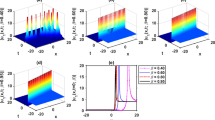Abstract
A partition of unity finite element method for numerical simulation of short wave propagation in solids is presented. The finite element spaces were constructed by multiplying the standard isoparametric finite element shape functions, which form a partition of unity, with the local subspaces defined on the corresponding shape functions, which include a priori knowledge about the wave motion equation in trial spaces and approximately reproduce the highly oscillatory properties within a single element. Numerical examples demonstrate the performance of the proposed partition of unity finite element in both computational accuracy and efficiency.
Similar content being viewed by others
References
Deraemaeker A, Babuska I, Bouillard P. Dispersion and pollution of the FEM solution for the Helmholtz equation in one, two and three dimension[J].Internat J Numer Methods Engrg, 1999,46(4): 471–499.
Zienkiewicz O C. Achievements and some unsolved problems of the finite element method [J].Internat J Numer Methods Engrg, 2000,47(1): 9–28.
Melenk J M, Babuska I. The partition of unity finite element method—basic theory and applications[J].Comput Methods Appl Mech Engrg, 1996,139(3): 289–314.
Duarte C A M, Oden J T. Anhp adaptive method using clouds[J].Comput Methods Appl Mech Engrg, 1996,139(3): 237–262.
Ortiz P, Sanchez E. An improved partition of unity finite element model for diffraction problems[J].Internat J Numer Methods Engrg, 2001,50(12): 2727–2740.
Laghrouche O, Bettess P, Astley R J. Modelling of short wave diffraction problems using approximating system of plane waves[J].Internat J Numer Methods Engrg, 2002,54(10): 1501–1533.
Durate C A, Babuska I, Oden J T. Generalized finite element methods for three-dimensional structural mechanics problems[J].Computers and Structure, 2000,77(2): 215–232.
Strouboulis T, Babuska I, Copps K. The design and analysis of the generalized finite element method[J].Comput Methods Appl Mech Engrg, 2000,181(1): 43–69.
Author information
Authors and Affiliations
Corresponding author
Additional information
Communicated by ZHONG Wan-xie
Project supported by the National Basic Research Program of China (973 Project) (No. 2002 CB412709) and the National Natural Science Foundation of China (Nos. 50278012, 10272027, 19832010)
Rights and permissions
About this article
Cite this article
Xi-kui, L., Hao-yang, Z. Partition of unity finite element method for short wave propagation in solids. Appl Math Mech 26, 1056–1063 (2005). https://doi.org/10.1007/BF02466419
Received:
Revised:
Issue Date:
DOI: https://doi.org/10.1007/BF02466419




